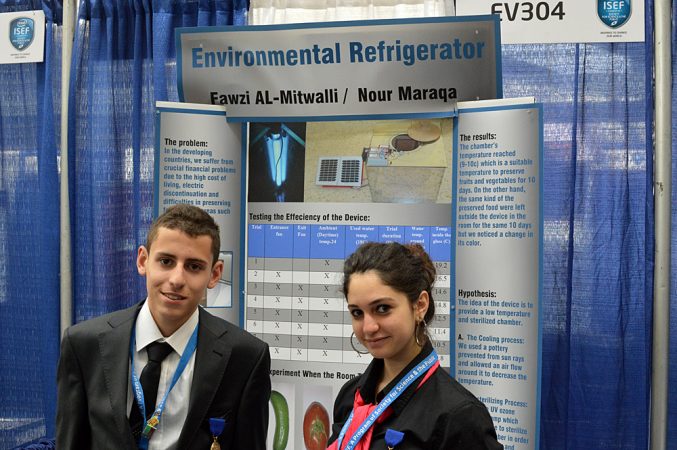Chillin’ in the desert
Simple, inexpensive and eco-friendly fridge keeps fruits and veggies fresh for days
By Sid Perkins

It’s a challenge to keep anything cool in a blazing desert, especially if there’s no electricity available. But a pair of 16-year-old high school students from Amman, Jordan, has invented a new device that can help keep fruits and vegetables from spoiling for well over a week.
Fawzi Al-Mitwalli and Nour Maraqa, both 10th-graders at the Al-Ra’ed Al-Arabi School, described their eco-friendly chiller May 15 at the Intel International Science and Engineering Fair in Pittsburgh, Pa. The event is sponsored by Intel Foundation and run by the Society for Science & the Public (which publishes Science News for Kids).
The new device is simple and inexpensive. It works by harnessing the power of evaporative cooling: When water evaporates, or transforms from a liquid to a gas, it absorbs large amounts of heat. In the young inventors’ prototype, a tall glass box (which holds the food to be chilled) sits inside a large, porous pottery container filled with water. That container is placed inside a box made of mirrored glass. Those mirrors reflect much of the sunlight, preventing it from shining into the box and heating up the container inside.
Two small fans mounted on opposite sides of the mirrored box (and powered by a small solar panel) help circulate warm air around the pottery container. One fan pulls warm air into the box; the other pushes air out of the other side. Water that had soaked through the side of the pottery container is evaporated by the air flowing past. This cools the water inside, which in turn chills any food stored in the innermost glass box. Two small batteries store power generated by the solar panel. This ensures the fridge works both in daytime and at night.
The team’s experiments show that when the outdoor air temperature is 24° Celsius (a little over 75° Fahrenheit), the temperature inside the food compartment is slightly less than 10°C (50°F). The team’s tests show that under such conditions, tomatoes and cucumbers in the fridge will stay fresh and edible for 10 days, while those unchilled for the same period of time will spoil.
The solar panel also powers a small ultraviolet lamp inside the cooling compartment. This lamp produces ozone that kills or stifles the growth of food-spoiling microorganisms. In contrast to most refrigerators, in which a light turns on when the door is open, the UV lamp in the team’s eco-fridge turns off when someone lifts the cooler’s lid. This feature helps protect a user’s eyes from harmful levels of ultraviolet light.
Altogether, the parts the young inventors used to make their device cost less than $100 (U.S.), much less than the cost of a conventional refrigerator. And besides being useful in desert areas that have no electricity, the eco-fridge will serve well in areas where power is unreliable — an unfortunate situation that applies to much of the Middle East, the researchers note.
Young inventors Fawzi Al-Mitwalli and Nour Maraqua describe the design of their eco-fridge and discuss how it works.
This is one in a series of articles covering the Intel ISEF 2012 competition. Check back soon for more stories.